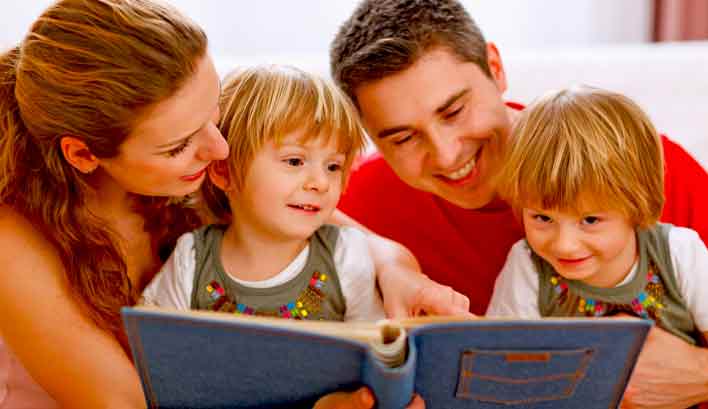By Jan Jamieson, OA&FS Counselor. Some adoptive and birth parents find conversations about adoption daunting. Even with openness, regular visits, and pictures hanging on the wall of one another, some families somehow miss starting these conversations. Immediately after an adoption, parents are immersed in diapers and feedings, parenting groups and parenting books as well as sleepless nights with fussy babies. Then one day they suddenly realize how much time has elapsed, how old their child is and at that point, the “adoption conversation” seems more challenging. Here is a simple guide to get you going no matter where you are in your process.
Starting the conversation.
In the best case scenario, conversations with a child about his/her adoption begin the day they are welcomed into their adoptive family. We recommend that adoptive parents tell their child the story of their adoption from the very beginning, not with the expectation that the newborn/infant will understand the story, but that the adoptive parents will become accustomed to hearing the words. By telling the story early and often, the more comfortable and relaxed the adoptive parents will feel. Here’s an example: “Today was such a huge day for all of us: you, your birth parents Sally and Joe, your birth grandparents and for us. You have so many people around you that love you and many of them were at your entrustment ceremony today. I can imagine that you will have lots of questions for us in the future and you can always talk with us about anything. Sally and Joe are so important to us. We love them.”
Continuing the conversation as your child grows and develops.
How does the conversation continue over the years? Bringing up adoption in daily conversation is much easier for a child to digest than sitting the child down for “the big talk.” As the child hears their story and begins to understand the significance of the roles of his/her birth parents, they will see that the door has been opened for further discussion. This will enable them to ask questions, and as they grow they will feel like they have always known that they were adopted.
The importance of photos and lifebooks.
Infants love to look at faces. Making small photo albums early on to show the child as they listen to their story can be helpful. Adding to these as they grow and revisiting them often is a great way to illustrate the child’s evolving story over time. (See Beth O’Malley’s website www.adoptionlifebooks. com for free articles, recommendations, suggestions, and tips.) Adoptive parents can elaborate on the story as they narrate it, “Shannon was so tired that day after you were born but so excited to finally see you!” Or “I wonder if your birth mother Nicole ever had any cravings when you were in her tummy/uterus. Maybe she craved strawberries and that’s why you love them so much?!?” Or “It was so wonderful that all of us could be there when you were born!” It is important to ensure that all of the details that are included are ones that the adoptive parents know to be true. Validating similar characteristics, talents and interests. “It’s amazing how you and your birth father John have the same curly hair! I bet you inherited that from him. I wonder how John felt about his curly hair when he was growing up. Should we ask him that the next time we see/call him?”
Making the most out of holidays.
“I always think about Joanne on Mother’s Day, would you like to make her a card or give her a call?” or “I love Thanksgiving because it is the perfect time to think about people and things we are thankful for, and we are so thankful for you and your birth family.”
Reading adoption-related children’s books.
Another way adoptive parents can open up a conversation adoption is to read adoption-related children’s books to their child. They can start a conversation by asking their child how they feel about various themes in the book. Similarities and differences to their story can be discussed. One adoptive mother told me that her son’s birth grandmother sent her several children’s books that used to be the birthfather’s favorites when he was growing up. What a great connection to share with a child!
When the child asks questions, adoptive parents can answer them honestly and simply.
Questions will likely be asked more than once as the child matures and develops. Over time, they will gain a more complex understanding of their story as they are provided with more in-depth information, some of which may be difficult to share or hear. A three-year-old is not ready to hear or process all of the details, so starting with a simplified and honest conversation to build on over time is a great approach. Layering helps to meet children where they are as they enter new developmental phases.
Answer with delight
“I’m so glad you asked me that/brought that up!” “You can always come to me with questions.” Being open and approachable to your child sends a message that the topic of his/her adoption story is nothing to be ashamed about or avoided. Being sensitive to how adoption discussions are being received by the child is also important, and reading their responses can help guide the adoptive parent as they decide whether to continue a conversation or to shelve a topic for a later discussion. Even if they have little to no contact with the child’s birth parents, the spirit of open adoption can still be present. Adoptive parents can let the child know that they think about his/her birth parents often. Children can create a birth parent box for pictures, letters or drawings that they want to share with their birth parent(s) the next time they see them.
Include birth parents in the conversation.
If possible adoptive parents can reach out to the child’s birth parents as their story is shared. Make it a joint effort. Adoptive parents can talk with the birth parent(s) about the timing of sharing sensitive details. This is the birth parents’ story too, so it’s important to demonstrate respect and empathy for their experience.
Reach out to OA&FS and the adoption community.
One of my favorite aspects of working with OA&FS is re-connecting with families, birth and adoptive, over time. Please feel free to connect with any of the agency counselors if you are interested in discussing this topic further.













